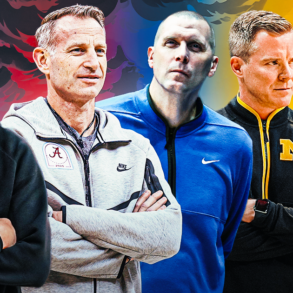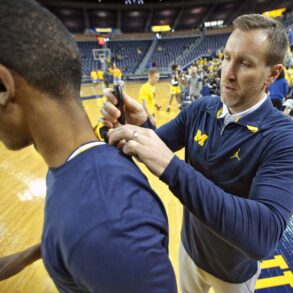The Gazette offers audio versions of articles using Instaread. Some words may be mispronounced.
DES MOINES — Brian Hardin still remembers the conversation with his boss on the second floor of Marquette University’s Al McGuire Center.
Hardin, the deputy athletics director at Marquette at the time, was talking to the athletics director Bill Scholl in Scholl’s office overlooking 12th Street and Wisconsin Avenue in Milwaukee on “some night when most folks are gone.”
“We were talking about if I were to leave to become an AD somewhere, what would that look like?” Hardin said. “The first thing he said is make sure that you’ve got a president who understands the role of athletics and is supportive of that.”
Almost a decade later and 300-plus miles to the southwest of his now-retired mentor’s office, that same concept of “alignment“ has helped Hardin lead Drake’s basketball programs to a new level of success — and potentially a higher ceiling for the state’s only private Division I program.
“We’ve got great institutional alignment from our board of trustees, to our president, to our senior leadership of athletics and down through our head coaches,” Hardin told The Gazette. “You got to have all those groups on the same page to make your department go from one spot to another.”
That alignment has been particularly noticeable in the men’s basketball program as the Bulldogs come off three consecutive seasons with NCAA tournament appearances. That is a first for Drake since Maury John’s three straight bids in 1969-71.
Drake has won 20-plus games in seven consecutive seasons — the longest streak in program history. That’s all despite multiple coaching changes, as Niko Medved left for Colorado State in 2018 and then Darien DeVries left for West Virginia in 2024. (Now, Medved is at Minnesota, and DeVries is at Indiana.)
“We’ve surrounded that program with the right people and the right amount of resources that, when we’ve lost a player or a coach, we’ve been able to try to go out there and replace it and try to keep this going in the right direction,” Hardin said.
Drake’s men’s basketball success reached new heights in 2024-25, when Ben McCollum led the Bulldogs to a program-record 31 wins and the team’s first NCAA tournament win outside of play-in games — an upset over sixth-seeded Missouri — since 1971.
“Then the next day, on that Friday, when we’re still alive, we’re walking around downtown Wichita,” Hardin said. “There’s a lot of Drake fans there, and we’re all kind of floating. … We were all smiling, high-fiving and everybody was feeling really good about what we had watched the day before.”
Drake had a party in Wichita that bore some resemblance to what Drake fans have at Peggy’s in Des Moines during the week of Drake Relays. It made for a “rewarding experience” as Hardin saw the “appreciation and the satisfaction on the faces of alumni who came in from literally all over the country for that.”
The Big Ten school down the road from Drake then was the one celebrating a week later as Iowa poached McCollum to be the Hawkeyes’ next head men’s basketball coach. For the third time in less than eight years, Hardin had to search for a men’s basketball coach.
“I was giving a couple of the search firm guys grief,” Hardin said. “Maybe there should be a finder’s fee that gets sent back to Drake here.”
Drake landed Eric Henderson, who posted a 129-60 overall record and won 79 percent of Summit League games in six seasons as the head coach at South Dakota State. It followed a search where the “interest was greater and stronger for this job than any of the previous head coach searches.”
Henderson said in his introductory press conference that his predecessors have “done great things” at Drake, “but I can tell you the best is yet to come.”
Could Drake become Gonzaga of the Midwest?
Amid a burgeoning level of success in men’s basketball — not to mention sustained success in women’s basketball with Allison Pohlman currently and Jennie Baranczyk before that — Hardin similarly envisions more moments like what he witnessed in Wichita earlier this year.
“This doesn’t have to be it,” Hardin remembers telling people at the Peggy’s-style event in Wichita. “We haven’t reached a goal. This is just another step on our journey. … The conversations we had there and those that followed, I think, have given me even more reason to believe that the best days are yet ahead.”
Other mid-majors have sprouted into consistent college basketball powers — or at least schools that can consistently appear in NCAA tournaments and win games at that level.
Gonzaga has earned a whopping 26 consecutive NCAA tournament bids. West Coast Conference rival Saint Mary’s has been to nine of the last 16 NCAA tournaments and has been seeded seventh or better in the last four tournaments.
“I do think that there is a space for us similar to what Saint Mary’s has carved out in the West Coast, what Gonzaga has carved out in the Northwest,” Hardin said. “I think there’s a space for Drake to kind of fill that void in the Midwest.”
Hardin is hesitant to outright say the Bulldogs could be the Gonzaga of the Midwest — “I don’t ever say that,” he said while noting the difference in resources — but Gonzaga was not always the mid-major power that it is now.
Before 1998-99, Gonzaga had been to only one NCAA tournament in program history, and that was as a No. 14 seed in 1995.
“Gonzaga — you look at the history of them — there’s not much before 1998,” Hardin said. “So everything they’ve achieved has really been in the last quarter-century. You look out over the next quarter-century, somebody’s going to emerge.”
The Missouri Valley Conference has been a springboard for other programs, whether it be Cincinnati and Louisville in the 1970s, Big East-bound Creighton in 2013 or most recently Atlantic 10-bound Loyola Chicago in 2022.
“Someone is going to attempt to grab this and say they’re now the premier program in the Missouri Valley Conference,” Hardin recalled saying at a staff meeting after Loyola’s departure. “As I look at it, there’s maybe three or four schools that I think will be really committed to that. … We’re one of them.”
Hardin himself gives Drake fans another reason for optimism. His university president Marty Martin described Hardin as the “best athletic director in the country” during Henderson’s introductory press conference. One does not need to look far to understand why Martin — a former administrator at Gonzaga — is so optimistic about Hardin’s leadership.
Since leaving his alma mater Marquette in late 2017, Hardin has overseen significant Knapp Center renovations, construction of a new soccer stadium, fundraising growth and top-three conference finishes for 14 of Drake’s 18 intercollegiate teams.
Then there’s the “great support” from fans, along with the potential for even more support in the Des Moines area.
Drake is in the third-largest metropolitan area in the Missouri Valley Conference, and the two with larger markets — UIC in Chicago and Belmont in Nashville — play second fiddle (or more like third, fourth or fifth fiddle) to professional sports teams in the area.
“Creighton is so strong because of its fans who are not alumni of Creighton, but understand the impact that it has on Omaha,” Hardin said from a Des Moines restaurant a couple blocks away from his office that sells merchandise in Drake blue. “I’d love to see that with Drake.”
Making a Creighton-esque jump in the college basketball hierarchy still is undoubtedly a daunting task, however.
The Jays had a stretch of five consecutive NCAA tournament appearances under Dana Altman from 1999-2003, yet it took another decade (and a wave of conference realignment) before Creighton could jump from the MVC to the Big East.
Butler’s ascent from the Horizon League to the Big East was fast, but it followed Brad Stevens’ back-to-back national championship game appearances.
Overcoming financial challenges
Perhaps the biggest challenge is the growing financial difference between the haves and have-nots in college athletics. The Missouri Valley Conference reported $13.9 million in revenue in a publicly accessible tax form for the 2022-23 fiscal year.
In comparison, the Big East Conference — the most prestigious nonfootball conference — reported $87.2 million in revenue in that same fiscal year.
“If it was always about the schools that spent the most would always win championships, then the Yankees would win every year in Major League Baseball,” Hardin said. “ … There’s still a place in Major League Baseball for the American League Central, for those mid-level-market teams that can still play really meaningful baseball.”
The 2024-25 season was a case study for that, as Drake dismounted the ACC’s Miami (Fla.), the SEC’s Vanderbilt and Missouri and the Big 12’s Kansas State en route to finishing with a 31-4 record.
“We still can find ways to punch above our weight class,” Hardin said.
Hardin also is confident in Drake’s financial resources compared to most of its Missouri Valley counterparts.
“For what we need to do relative to how we support our head coach, the coaching staff, what their operating budget looks like and what we’re able to do on the collective side, I feel like we’re at or near the top of our conference,” Hardin said.
Preparing for post-House settlement reality
Hardin has not definitively said yet whether Drake will participate in direct revenue sharing in 2025-26 following the House vs. NCAA settlement.
“A lot of things changed” when a federal judge told the settlement parties last month to grandfather existing athletes into the roster limits, though. As Hardin saw it, that was the “one hang-up that’s kind of kept some schools from fully accepting it and embracing it.”
At Drake specifically, the anticipated change to the House vs. NCAA settlement is “going to give us something to kind of reflect on.”
“Maybe our initial plan needs to change because what we are now aware of is going to force us to do so,” Hardin said.
However Drake’s athlete compensation looks in 2025-26 and beyond, Hardin recognizes the importance of a “thriving men’s and women’s basketball program and Drake Relays.”
“Those three areas — both basketballs and Relays — drive significant revenue back to our department,” Hardin said. “So we need to do what we can to put those in a position to be successful. … That’s the rising tide that lifts all the boats in our department.”
As for Hardin’s evening conversation on the second floor of the Al McGuire Center almost a decade ago, Hardin also talked with his wife Cara about “what locations would work for our family.” Drake unsurprisingly made the Des Moines native’s list, and then the job came open when Sandy Hatfield Clubb stepped down in 2017.
“It was at a time that I think a lot of folks around Drake were starving for us to become relevant again in many of our sports,” Hardin said. “And we’ve been fortunate to come in here and get some really good people in and around our programs. … The rest is kind of history.”
Comments: john.steppe@thegazette.com
Sign up for our curated Iowa Hawkeyes athletics newsletter at thegazette.com/hawks.
This post was originally published on this site be sure to check out more of their content.




